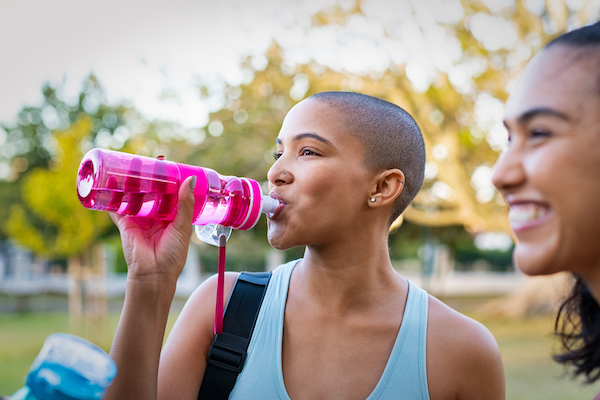You’re halfway through a three-mile run, intense Pilates class, or round of your weight circuit when — suddenly — you’re feeling nauseous.
Despite your best intentions to push on with your workout, you’re forced to stop, sit down, and struggle just to take steady breaths.
Within moments, your body feels zapped of energy. What little strength you have left is used to fight back a gag reflex.
Sound familiar?
Exercise-induced nausea, or feeling nauseous after a workout, is a common phenomenon, one that most people — fitness experts and novices alike — have experienced at some point.
Why Do I Get Nauseous When I Work Out?
Kyrin Dunston, MD says vomiting or nausea during or after exercise usually has to do with one or more of the following factors:
- Hydration (too little or too much)
- Nutrition (whether or not you’ve eaten, and what you ate)
- Workout intensity vs. baseline fitness level
- Specific exercise
- Anxiety
- Gastrointestinal dysfunction
- A serious medical condition
The cause of your exercise-induced nausea may not be evident at first, but one thing’s for sure: Throwing up when you’re trying to work up a sweat is zero fun.
Not only does it derail your workout, but it also makes it difficult to feel motivated and excited to continue challenging your body.
The good news? That turbulent feeling in your stomach is avoidable if you take the proper precautions.
1. Eat and Hydrate Properly
To prevent nausea, be smart about when and how you fuel your body before a workout.
Give yourself at least an hour to digest a meal before you start moving, recommends Kristin McGee, an ACE-certified personal trainer based in New York City.
Keep pre-workout meals light, and be sure to include both proteins and carbs if you can.
If you’re hungry and can’t wait an hour to work out, opt for a banana, handful of raisins, or an energy gel, all of which can be digested quickly.
As for fluids, make sure you’re hydrated, but don’t overdo it.
There’s no need to chug all the water in your 24-ounce bottle 10 minutes before you start your run — an eight-ounce glass or two will do the trick.
And though sports drinks can help replenish lost minerals, the high sugar content of many of them can subvert your hydration efforts.
Dunston says it’s important to consume sports drinks in accordance with the duration and intensity level of your workout.
Good old-fashioned H20 is sufficient under most circumstances, but for those seeking an edge during particularly tough or long workouts, try a low-sugar sports drink that maximizes fluid absorption and replenishes lost electrolytes.
Possible risks of too much or too little food and water
Dunston says dehydration — when your body doesn’t have enough water to function optimally — is a significant cause of feeling nauseous after a workout.
The other possibility? You guzzled too much H2O, and your stomach is overly full.
“How recently you have eaten and what you ate before your workout can be issues as well,” says Dunston. “Low blood sugar, or hypoglycemia, is particularly a problem if you work out in the morning and don’t eat anything beforehand.”
If that’s the case, Dunston says you’ll usually experience both nausea and dizziness.
Overeating before exercise also pits your stomach against your muscles.
Dunston says the body moves blood to the gastrointestinal system to help with digestion.
But if you exercise on a full stomach, your body also has to send blood to your muscles to support their movements.
When your body tries to handle both digestion and strenuous exercise simultaneously, there isn’t enough blood flow to assist with digestion, Dunston says. Nausea can result.
“Nausea is a precursor to vomiting,” says Dunston. “Dumping out the food in the stomach is one way the body can alleviate the blood supply problem.”
2. Lower the Intensity
If you haven’t prepared your body for a specific type of exercise or intensity (like running five miles at a seven-minute pace, or swimming laps non-stop for 30 minutes), don’t go at it full force.
When you’re not used to a certain speed, distance, or movement, it’s essential to ease into it and adjust your expectations accordingly.
“Keep the intensity level within your tolerated range,” says Dunston.
In other words, don’t assume you can handle a hilly six-mile trail run if you’ve only ever jogged on the comparatively flat streets of your neighborhood.
Make an effort to approach new workouts and movements with equal parts enthusiasm and caution.
When you do feel ready to increase your pace, distance, or reps, do it gradually, and be sure to notice when your body starts to feel overworked so you can back off before you hit your breaking point.
Possible risks of overexertion
The line between pushing yourself to run two more minutes and pushing yourself to the point of nausea can be blurry.
Exercise isn’t supposed to be easy (it’s meant to challenge you, after all), but it shouldn’t make you so sick that you can’t complete a workout.
McGee says overexertion can lead to nausea.
“If you’re exercising at an intense level or pushing yourself past your threshold, your body reacts by increasing blood flow to your muscles, heart, lungs, and brain so your body can process energy and continue working out,” she says.
“When this happens, blood is diverted away from your stomach and that can make you feel sick.”
3. Warm Up Properly and Avoid Exercising in Extreme Conditions
If you go from sitting at your desk to running at full speed without a sufficient transition period, you’re going to overexert yourself before you even get into your workout.
To prevent nausea by overexertion, McGee says it’s crucial to warm up your muscles before you start working them.
Depending on your workout, you can jog lightly for five to 10 minutes, walk briskly for a few minutes, or do some dynamic stretching to boost blood flow, activate your central nervous system, and optimize strength, power, and range of motion.
Another tip? Avoid working out in extreme conditions, says McGee.
Exercising in overly humid or hot environments can lead to heat exhaustion, nausea, and dizziness if you’re not careful.
If you love hot yoga or outdoor runs in the summer, don’t stress — stay adequately hydrated and start slow to give your body time to adjust to the high temperature.
Other Possible Causes of Nausea While Exercising
1. Disorienting movements
“Specific exercises, particularly those that contract the abdominal wall muscles and those that require head twisting can induce nausea as well,” Dunston says.
Moves like crunches apply extra pressure to the stomach, says Dunston, while twisting motions can cause the inner-ear vestibular system — the network of sensory components in charge of our sense of balance — to become disoriented.
Anyone who’s ever closed their eyes during sit-ups or tried to do camel pose at the end of a yoga class knows what happens when your body feels off balance: You get nauseous.
2. Performance anxiety
If you’re involved in a competitive event in which there’s enormous pressure to succeed — like a race, sporting match, or weightlifting competition — you might experience occasional or constant performance anxiety, which can cause you to feel overly nervous and nauseous.
You don’t have to take the starting line of a 10K or Tough Mudder to feel anxious, though.
Dunston says any exercise under pressure can cause serious nerves.
“It could be as simple as being in a new [workout] class where you are concerned with keeping up and looking good,” says Dunston.
3. Larger health concerns
Dunston says exercise can sometimes exacerbate the symptoms of gastrointestinal disorders and other health conditions, causing nausea and other problems.
“If the nausea persists despite addressing all of the above concerns, it’s best to see a doctor to be evaluated for underlying potential health issues that need to be addressed,” says Dunston.
What to Do if Your Workout Makes You Nauseous
Even when you think you’ve done everything right, sometimes nausea just happens.
When that horrible, sick-to-your-stomach sensation starts to creep up on you, Dunston says it’s best to rest for a few minutes.
Stop what you’re doing and find something sturdy to sit or lean against.
If the nausea doesn’t subside, “it might be best to call it quits for the day or lower the intensity of the activity,” says Dunston.
The post How to Avoid Getting Nauseous When You Exercise appeared first on The Beachbody Blog.





0 Comments